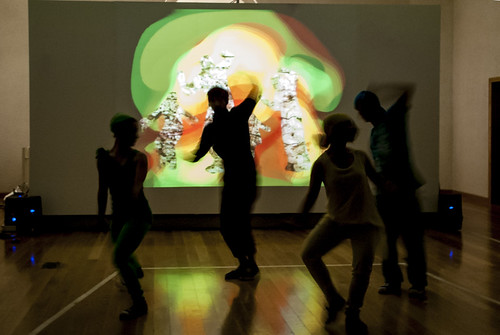Italiano/English
Il 17 e 18 Luglio 2014 si è svolta la manifestazione “Caotiche tracce tecno umane”, installazioni elettroniche con incursioni coreografiche e laboratori per bambini, a Palazzo di Primavera, a Terni.
On 17th and 18th July, 2014, we held the event “Chaotic techno human tracks”, electronic installations with choreographic interventions and workshops for children, at Palazzo di Primavera, in Terni.
La manifestazione è stata organizzata grazie a: Comune di Terni, Assessorato alla Scuola, Direzione Servizi Educativi e Scolastici e all’interno di UmbriaScienza e dell’accordo di programma finanziato dal MIUR tra partner regionali pubblici e privati per la diffusione della cultura scientifica.
In entrambe le serate siamo stati impegnati in un percorso nell’intero palazzo.
A piano terra si è tenuto un laboratorio di circuiti morbidi, per bambini dai 5 ai 10 anni, mentre al secondo piano abbiamo portato l’installazione dei robot caotici 2.0. Gli effetti grafici della proiezione sono stati migliorati ed arricchiti, mentre due robot hanno ottenuto una scocca progettata e stampata in 3D da GreenTales. Hanno fatto capolino anche BoBeBo ed il risolutore di cubo di Rubik, realizzato con Lego Mindstorms.
The event was organized thanks to the Municipality of Terni, Department of School, Management of Educational and School Services, within UmbriaScienza network acivities and the agreement program funded by the Ministry of Education among regional public and private partners for the spread of scientific culture.
On both evenings we were engaged throughout the whole building.
On the ground floor there was a soft circuit workshop for children aged from 5 to 10 years, while on the second floor we brought the installation of the chaotic robots 2.0. The graphic effects of the projection have been enhanced and enriched, while two of the robots have got a body designed and 3D printed by GreenTales. Also BoBeBo and our Rubik’s Cube Solver, made with Lego Mindstorms, appeared.
Al terzo piano si poteva assistere ad uno spettacolo di danza, pensato appositamente per essere eseguito con il supporto di un Kinect: quattro ballerini rappresentavano i quattro elementi naturali (acqua, fuoco, aria e terra), visibili nella proiezione che distingueva i diversi elementi grazie ai quattro colori degli abiti dei danzatori (Chiara, Valeria, Jacopo e Gabriel). La coreografia, di Olga Ziello, era preceduta da una breve introduzione sulla teoria del caos, di cui fa parte la fluidodinamica. Nella proiezione infatti i quattro elementi si muovono all’interno di un fluido, lo animano e vi creano delle turbolenze che ne rendono il comportamento caotico. Durante ogni serata, il balletto si è ripetuto per quattro volte.
On the third floor there was a dance performance, specially designed to be performed with the support of a Kinect: four dancers represented the four natural elements (water, fire, air and earth). The projected elements were distinguished by the four colors of the dresses of the dancers (Clara, Valeria, Jacopo and Gabriel).
The choreography, by Olga Ziello, was preceded by a brief introduction about the chaos theory, which is part of the fluid dynamics. In fact, the projection of the four elements moves within a fluid, animates it and creates turbulences that give the fluid a chaotic behavior. During each evening, the ballet was repeated four times.
Infine nell’auditorium si poteva assistere a dei filmati sull’attività dell’associazione e sulla teoria del caos:
Finally, in the auditorium there were videos about the activities of our association and the chaos theory:

